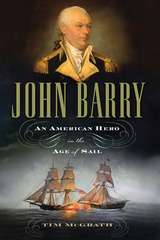
In the split second that it took Associated Press photographer Joe Rosenthal to snap the shutter of his Speed Graphic, a powerful and enduring American symbol was born. Iwo Jima: Monuments, Memories, and the American Hero tells the story of that icon as it appeared over the next forty years in bond drive posters, stamps, Hollywood movies, political cartoons, and sculpture, most notably the colossal Marine Corps War Memorial outside Washington, D.C. The book is also a brilliant and moving study of the soldiers who fought one of our bloodiest battles and of the impact of Iwo Jima on the rest of their lives.
When the famous photograph first appeared in newspapers in 1945 it was little more than a grainy outline of massed men and their wafting flag, but for millions it captured the essence of American grit and determination. The Marines pictured were in fact in no immediate danger—they were replacing a small flag planted earlier atop Mt. Suribachi with a larger, more visible one—but to an enthusiastic public they were heroes risking their lives for Old Glory. The Battle of Iwo Jima raged for many days beyond the capture of this one position, and ultimately claimed the lives of almost seven thousand American servicemen, yet already the tableau symbolized victory and, as a politician said at the time, “the dauntless permanency of the American spirit.”
With passion and meticulous care Karal Ann Marling and John Wetenhall illuminate the ironies and misconceptions that proliferated around the two Iwo Jima flag raisings. Pride and nostalgia exalted the glorious epiphany of Rosenthal’s image and suppressed the grisly and at times mundane reality of war. The ordinary men whose action had been immortalized became uneasy celebrities, while the planters of the first flag were doomed to oblivion. From John Wayne’s epic Sands of Iwo Jima to the gargantuan bronze boots of the War Memorial to the parade-floats of Mt. Suribachi done in sweet peas and orchid-colored pompoms, overwrought patriotism blended with true valor.
The authors weave a fast-paced and vivid story from the reminiscences of survivors, rare archival sources, and dozens of documentary photographs. They give the first comprehensive account of the building of the Marine Corps War Memorial, dedicated in 1954. And in a riveting final chapter they follow a group of American veterans who returned to the island in 1985 and met Japanese survivors. Dedicated to the men who fought on Iwo Jima, this groundbreaking study in cultural iconography transcends the icon to show the honor in remembering what really happened.

The Life of the First Captain of the United States Navy
Finalist for the Rear Admiral Samuel Eliot Morison Award for Excellence in Naval Literature
“Ashore as well as at sea, Tim McGrath paints an informative, engaging and highly entertaining portrait of this worthy but neglected hero of American independence. The author shows us a man who was a magnificent embodiment of common sense—and uncommon courage and dedication. That such a work is long overdue makes its achievement all the more pleasurable.”—Wall Street Journal
“Combining sophisticated use of sources with a pleasing writing style, McGrath masterfully rescues a father of the U.S. Navy from unmerited eclipse.”—Publishers Weekly
“A nearly indispensable addition to U.S. Navy collections.”—Booklist“McGrath employs exemplary narrative style in this work. . . . In John Barry, the author adroitly juxtaposes maritime history, narratives of naval combat, and early U.S. social history.”—New England Quarterly
“McGrath is a compelling and lucid writer. He brings Barry to life, makes battles understandable, and provides the clearest description of Barry's 1778 capture of the British transport ships Mermaid and Kitty that this reviewer has seen.”—Pennsylvania Magazine of History and Biography
“A great read and an absorbing account of a drama-filled life.”—Naval History
“Well researched, well written, and a pleasure to read, this book restores John Barry to the important place he once held as one of our nation’s great heroes. It is a tale of high adventure and personal courage and you will not want to put it down.” —JAMES L. NELSON, author of George Washington’s Secret Navy
“Readers of this vivid biography will imagine they smell the ocean’s salt air and the sulfurous fumes of gunpowder as they navigate these action-packed pages. Fans of Horatio Hornblower and Lucky Jack Aubrey will rejoice in discovering their real-life American counterpart.”—GREGORY J. URWIN, author of Facing Fearful Odds: The Siege of Wake Island
The man regarded as “the Father of the American Navy” returns to the quarterdeck in John Barry: An American Hero in the Age of Sail, the first comprehensive biography of this legendary officer in generations. Son of a hardscrabble Irish farmer from County Wexford, Barry was sent to sea as a child, arriving in Philadelphia during the restless decade before the American Revolution. Brave and ambitious, he ascended the ratlines to become a successful merchant captain at a young age, commanding the most prestigious ship in the colonies and recording the fastest known day of sail in the century.
Volunteering to fight for the Continental cause, Barry saw his star rise during the War for Independence. As captain of the Lexington, Raleigh, and Alliance, Barry faced down broadsides, mutinies, and even a fleet of icebergs. He captured the first enemy warship taken by a Continental vessel and fought the last battle of the American Revolution. His hard-won victory over two British warships simultaneously garnered him international notoriety, while his skill as a seafarer and cool temper established Barry as a worthy foe among British captains. Without a ship during the winter of 1776-77, the ever resourceful Barry lead a battery of naval artillery at the battle of Princeton. With peace came a historic voyage to China, where Barry helped open trade with that reclusive empire. In 1794, President Washington named Barry as the first commissioned officer in the new United States Navy. Given the title of commodore, Barry ended his career during America’s naval war with France, teaching the ropes to a new generation of officers, most notably Stephen Decatur.
Drawn from primary source documents from around the world, John Barry: An American Hero in the Age of Sail by Tim McGrath brings the story of this self-made American back to life in a major new biography.

READERS
Browse our collection.
PUBLISHERS
See BiblioVault's publisher services.
STUDENT SERVICES
Files for college accessibility offices.
UChicago Accessibility Resources
home | accessibility | search | about | contact us
BiblioVault ® 2001 - 2024
The University of Chicago Press









